How to Write Blog Intros and Openers (With Examples)

Making the first impression is essential.
But, unlike popular opinion, it's not the most essential ingredient to a quality blog.
Getting your foot in the door is necessary, but it isn't significant if the door isn't then opened for you. If your target jabs your foot with a broom and slams the door in your face, it doesn't matter how strong your opening line was.
In this metaphor, the "foot in the door" is your headline, the H1 title in Google search, and anywhere your content is posted.
The key isn't that title, though it's essential. The key is your opening lines. Your title draws people in; your intro has to grab the reader's attention and let them know they're in the right place.
How to Craft a Compelling Introduction
A good blog introduction is unique in content writing. Yet, the concept isn't.
Consider every book – especially fiction – that you've ever read. The first sentence doesn't need to be ripe with meaning; it needs to catch your attention. The entire purpose of the first sentence is to get you to read the second. The goal of the second sentence is to get you to finish the paragraph, and the purpose of the paragraph is to get you to complete the page. The author can only assume that you're invested and start to get into details.
This phenomenon is why many books start in media res, that is, in the middle of the action. It's more compelling than starting with pages of descriptions of a city from above or someone doing something mundane. That's not to say those kinds of intros don't exist – they do, and they can be compelling in a way – but it's a technique that has to be done correctly to work.
"It was a dark and stormy night."
You know this famous intro, but do you know the second line or which book it comes from? It's from Paul Clifford, a novel by Edward Bulwer-Lytton, published in 1830.

The entire line is actually:
"It was a dark and stormy night; the rain fell in torrents—except at occasional intervals, when it was checked by a violent gust of wind which swept up the streets (for it is in London that our scene lies), rattling along the housetops, and fiercely agitating the scanty flame of the lamps that struggled against the darkness."
It's memorable, but it's so bad that it has been used as an example of bad introductions for nearly 200 years. Ouch.
Contrast this with an academic paper. Academic writing starts with advice you probably remember from grade school essay writing. "Tell them what you're going to tell them." If you look at research papers in journals, you see this as the "Abstract," the introductory paragraph summarizing the whole study.
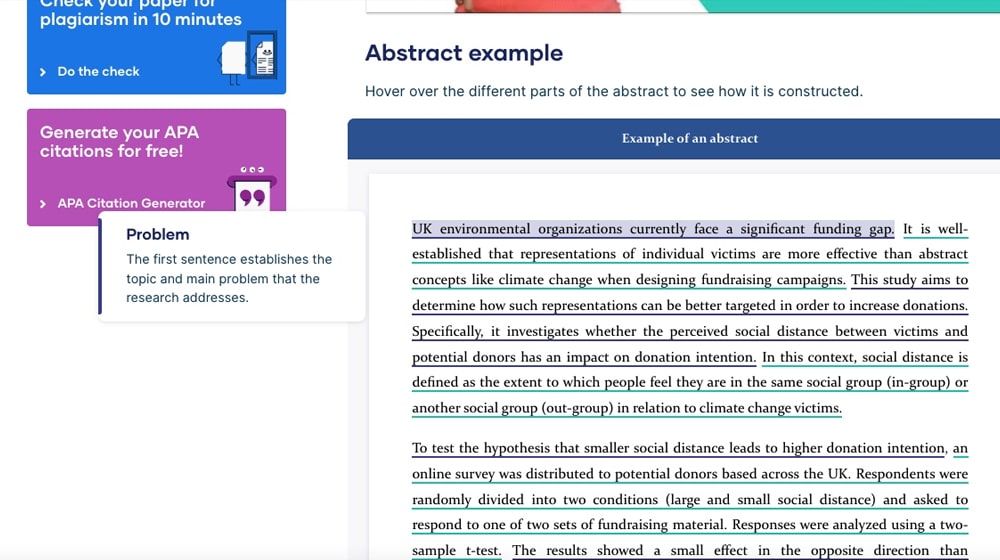
Blog posts are unique because they target a specific kind of audience, engage with them directly, and have a potential expectation of a conversation. A book? The author might expect to have conversations about the book, but it's not like the book has a comments section. A blog post does.
There's no such thing as a single good introduction. If there were, everyone would use it, and then it wouldn't be good anymore.
Scroll back up to the top of this post. Look at the first two sentences in my article. The first one tells you something you already know or think you do. The second refutes that and implicitly promises to give you more profound knowledge about the subject. I don't have to tell you that I'm going to discuss the subject of introductions (since you already know from the post title), but I promise detail if you only read on to find it.
The 7 Types of Blog Post Introductions
It's been a few years since I originally wrote this post, and I realized that talking about the 7 different types of introductions (with examples for each) practically deserves an entire guide on its own.
For me, I try to ask a question or two, leading towards my topic, like I did here. By getting a reader thinking about the answer to the question for them, I prime them to be receptive to the information I'm going to give them.
It's not always the best opener, though. It also suffers a little from the fact that someone landing on my blog post probably is already thinking about that topic, which is why they did the Google search that brought them to me in the first place.
But then, let's be real here: how often do you even read the intro to the blog posts you're reading? Did you even reading this one? (Let me know in the comments!)
I tend to take the view that most people aren't really reading an intro so much as skimming it to make sure the post they landed on is actually about the topic they wanted to find. People then skim down or click on a link in my table of contents and find the specific information they want to get.
There are a bunch of different strategies and perspectives you can take on your blog post intros, though. What are they, and when are they best used? Let's dive right in.
Strategy #1: The Leading Question
"When you sit down to start writing a blog post, how do you begin?"
The leading question is one of my favorite intro styles, and you see it a lot on my blog because of it.
A leading question helps to prime readers for the subject you want to discuss. More than that, though, it helps them view it through the same lens and at the same starting point you do. I often start mine from a point a step or two removed from the actual topic of the blog post, so I can lead people to the starting line with me.
After all, it's pretty important that everyone is on the same page when discussing a topic, right?
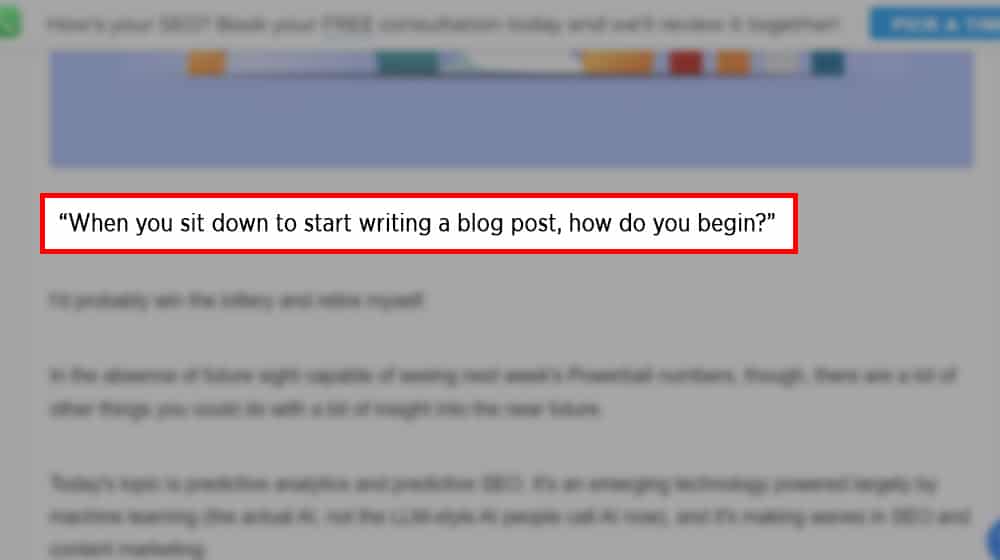
The downside to the leading question is that it's somewhat covered by your blog post title and, indeed, by the topic itself. If you're properly targeting keywords and the search intent behind them, there's a decent chance that the simple fact that people made it to your post at all means they're at that starting line and might just skip your intro entirely.
That said, as long as they keep scrolling rather than bouncing, that's good enough for me.
A variation on the leading question is more of a quiz question. Something like:
"What would you say is the most important element of SEO today?
- Backlink Building
- Content Marketing
- Technical Optimizations
- Influencer Outreach
The answer might surprise you."
It's basically the same as the leading question, but framed a little differently, and with the option to preemptively disregard certain side subjects you might not want to discuss in depth. By framing your topic within a set of choices and using the intro to explain why it's the choice you've picked, you set the stage for the rest of your content.
Strategy #2: The Personal Anecdote
"When I was waiting for a speaker at SXSW, I got to talking with the person next to me, who turned out to be a big name in marketing."
This shows up in a few different ways. One big example is the much-maligned food blog. It's fascinating why those personal anecdotes proliferated in the food blog space (short version: recipes can't be copyrighted, so the posts needed something unique for SEO to stand out), but it's just one potential example.
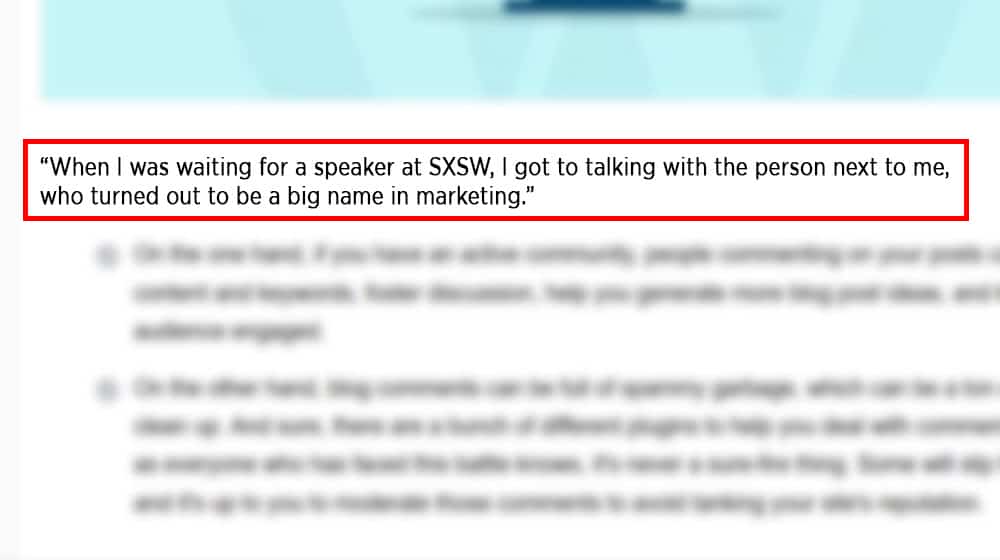
Another is popular in certain long-form editorial posts, the kind that start out with a personal story of the journalist driving through rural Virginia to meet with a kindly old man who ends up being the inventor of Napalm or something, and bounces between the contemporary interview and the retrospective, thoughtful analysis and bird's-eye context.
These can be good for conveying the writer's perspective and introducing some element of EEAT with the trustworthiness of getting authoritative information from an expert. On the other hand, they're almost cliché if they aren't very relevant, they're more easily skipped, and some people really just want more up-front information and tune out the whole style of post.
Strategy #3: The Bold Promise
"By the end of this blog post, you'll know how to get a million-view blog."
There are two styles of the bold promise.
The first is a big claim where you overpromise, but likely underdeliver. "If you read this blog post and do everything I tell you to do, your site will have a million monthly active visitors guaranteed" is the kind of promise that you pretty much can't possibly keep.
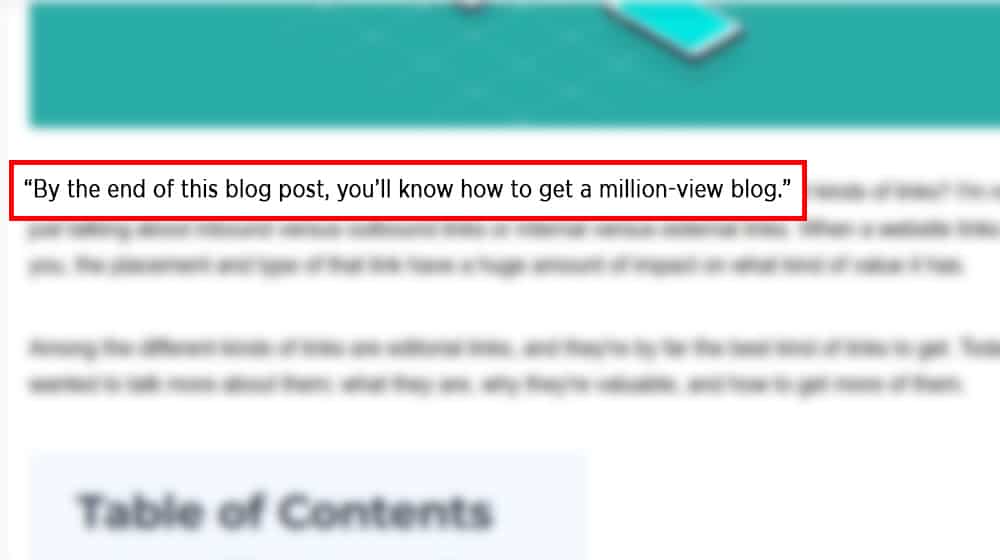
The other is a big claim that you back up with data because you've done it. You see this a lot with analyses of case studies from marketers. You make a promise of results and show proof that you've gotten those results with other clients already.
Depending on the promise, this kind of intro may or may not be better for certain kinds of long-form landing pages. If the claims you're making relate directly to your product or service, it tends not to work as well for basic content marketing.
Strategy #4: The Contradictory Statement
"I think the endless quest for backlinks is bad for SEO, and here's why."
There was an era in marketing where the contradictory statement was everywhere.
This was the same era when Facebook (and to a lesser extent, Twitter) drove immense amounts of traffic, so if you weren't focusing solely on going viral on those sites, you were going to fall flat. Since Facebook thrived on "rage bait" because angry comments are still engagement and still promoted the content, it was an easy way to drum up traffic.
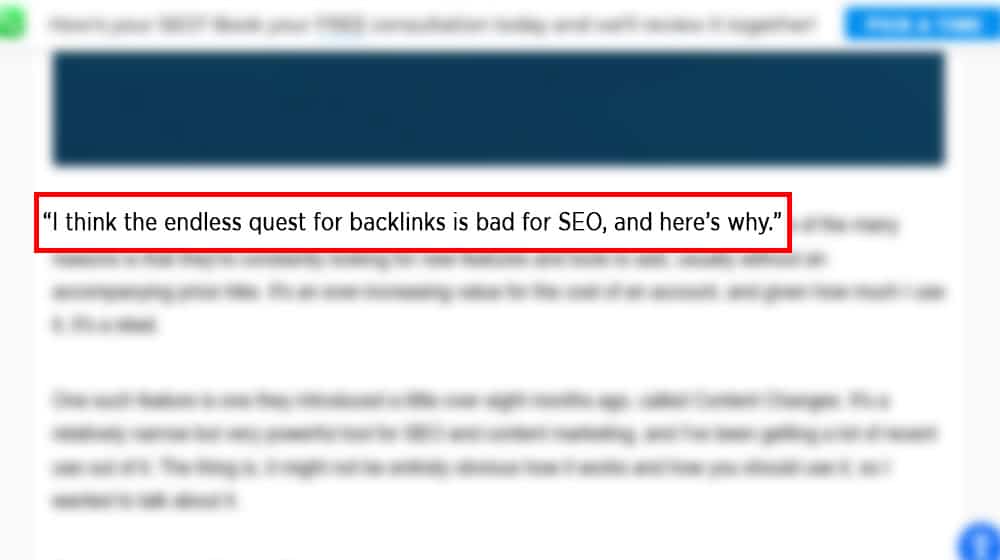
These days, two different pressures are making this a less valuable focus. The first is that social media is largely struggling, between the exodus to chat platforms, the saturation with AI-generated content, and the general loss of trust in the sites. The second is that Google seems to be pushing for more of a consensus model (possibly to make things easier for AI overviews), so being the person to stand out with a contradiction doesn't work as well.
It can still work, and it can still be effective, but it's not an easy slam dunk like it used to be.
Strategy #5: The PAS Framework
"Marketing is getting harder, and marketers are getting more desperate. It's poised to damage the internet irreparably, but we can stop it. Here's how."
The PAS framework stands for Problem, Agitate, Solution. In your introduction, you do those three things. You present a problem, you agitate the reader about it by giving them reasons why it will affect them personally, and then you present your solution, or the promise of a solution, as they read the rest of your post.
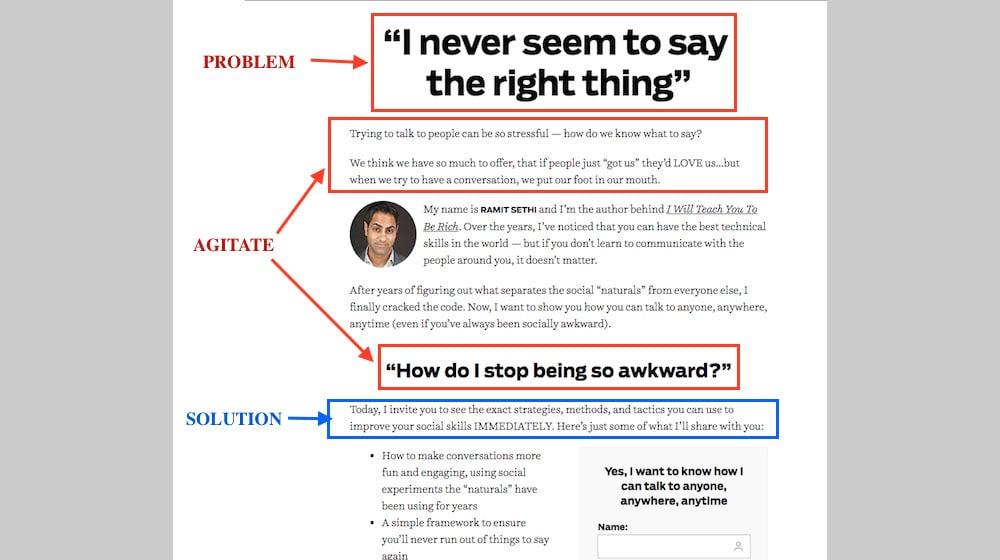
PAS is a fairly standard framework for journalism and activist writing. It can help people identify problems they didn't know about before, explain to people who didn't think a problem would affect them why they should care about it, and offer advice.
The downside is that this is a fairly standard framework, so you see it a lot, and it's not really that catchy as far as intros go. It's not going to win any awards, but it might still be good enough to get you traffic, especially if it's for some kind of industry activism.
Alternative frameworks with similar goals
The PAS framework is great for an introduction when you want to keep it short, but there are a handful of similar frameworks you can use for similar goals, with slightly different elements.
- The 4 Ps Framework. Problem (you present the problem your reader is facing), Promise (you make a promise about solving it), Proof (you showcase proof of you solving it for other people), and Proposal (your CTA to help the reader solve it as well.) This is most effective for landing pages, rather than blog posts, however.
- The AIDA Framework. Attention, Interest, Desire, Action. An attention-grabbing question leads into a pitch to interest readers in your expertise, you increase their desire with more details, and you round out a call to action. This is quite similar to the four Ps.
- The FAB Framework. Feature, Advantage, Benefits. This is most heavily used on product-focused content, landing pages, comparison pages, reviews, and the like.
My main gripe with frameworks like this is that they tend to come across as a little flat and formulaic. They don't have the same hook you want out of good content marketing.
Strategy #6: The Hopefully-Relevant Quotation
"Winning is great, sure, but if you are really going to do something in life, the secret is learning how to lose." – Wilma Rudolph.
Leading with a quote from someone important, with a statement that conveys the same concept you want to convey in your post, can be a way to thematically link your content with the content of the past.
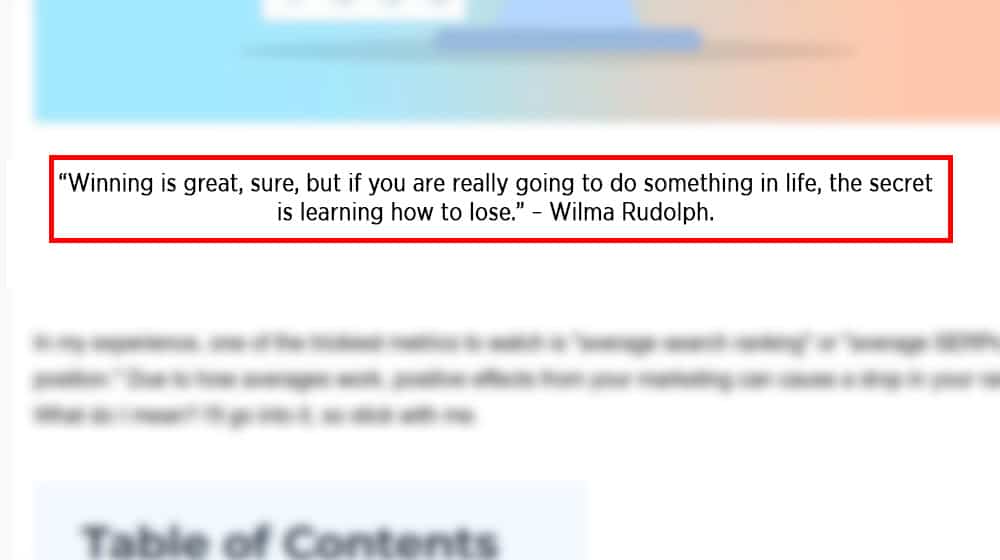
It's also fairly trite and, in my experience, still requires some other intro directly beneath it, so I almost don't even consider it an introduction. That goes doubly true for anyone who uses one of those same few dozen quotes you see everywhere, like the Einstein one, the Gretzky one, or the Ford one. See, I didn't even need to quote them, and you knew which ones I was talking about, right? Boring.
Strategy #7: The Contemporary Meme
"Who would win: 100 marketers, or one gorilla with a keyboard?"
Memes can be very engaging with the right audiences. They're also a fast-churning social industry, so the meme you reference now might be out of date by the time your blog post is published, let alone down the road.
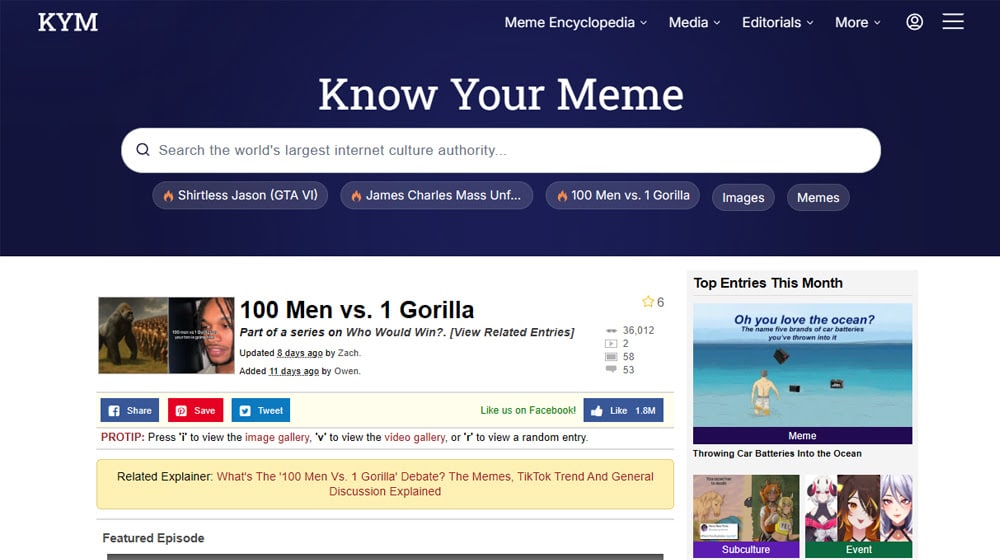
I've seen some blogs utterly fill their posts with memes. I've seen a few using them sparingly and only in the most relevant ways. I generally only like to use them sparingly myself, if at all. But, if your audience is receptive to them, go for it.
6 Expert Examples of Blog Intros
Now that we know the 7 types of intros: what are some other examples of good blog post intros, and bad ones? Let's take a look at them, and hopefully we can learn something to improve our own blogs.
And, hey, before I get too deep in the weeds: do you have a favorite blog post intro? Either one you wrote or one you read? Please post it in the comments and tell me why you like it.
Example #1 - Neil Patel
This first example comes from a Neil Patel article:
Here's the intro:
"What first attracts people to your content or blog entry?
It's the title (aka "the headline").
The title is the first thing people will see on a page. It's your first impression on readers.
Copyblogger estimated that 8 out of 10 people read the title. However, the title doesn't keep them reading through your blog content."
Let's start with a contentious one right out of the gate.
He does this a lot. He starts with a question, elaborates on it, and then cites why the topic is essential.
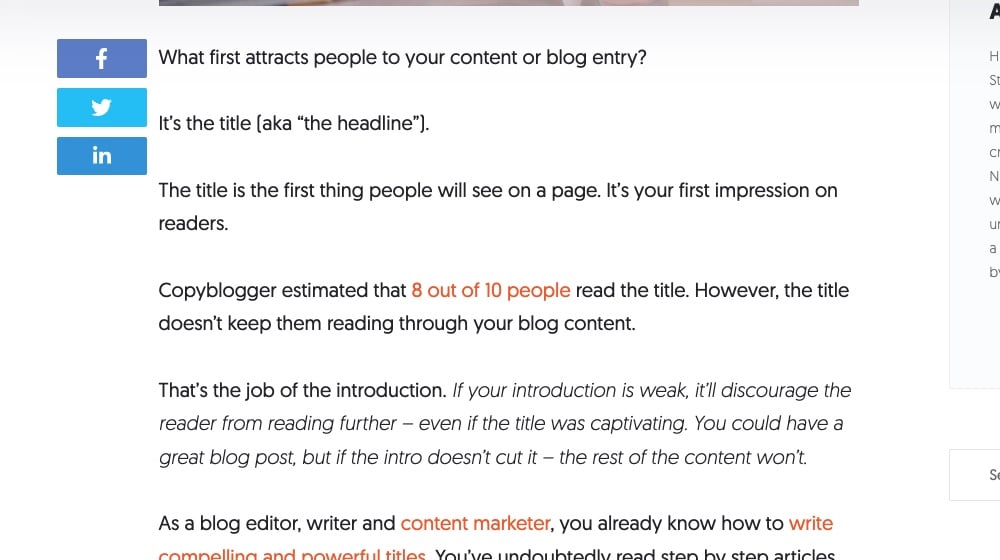
Here's another one from his post on SMS marketing:
The article starts off by saying:
"Did you know the average person checks their phone 344 times a day?
This statistic is just one of the reasons SMS marketing no longer sucks.
Seventy-one percent of people say they check their phones within 10 minutes of getting out of bed.
The point is that people keep their phones handy and are always ready to use them to find information or check the latest social media updates.
Plus, open rates for texts vastly surpass email—98 percent versus just 20 percent for email."
He used short sentences, punchy statistics, and a question. If you aren't already interested in the subject, the article draws you in and gives you data to back up why it's essential to care about it. He also suggests that you may want to focus on it more than your email list, since the open rate is five times better.
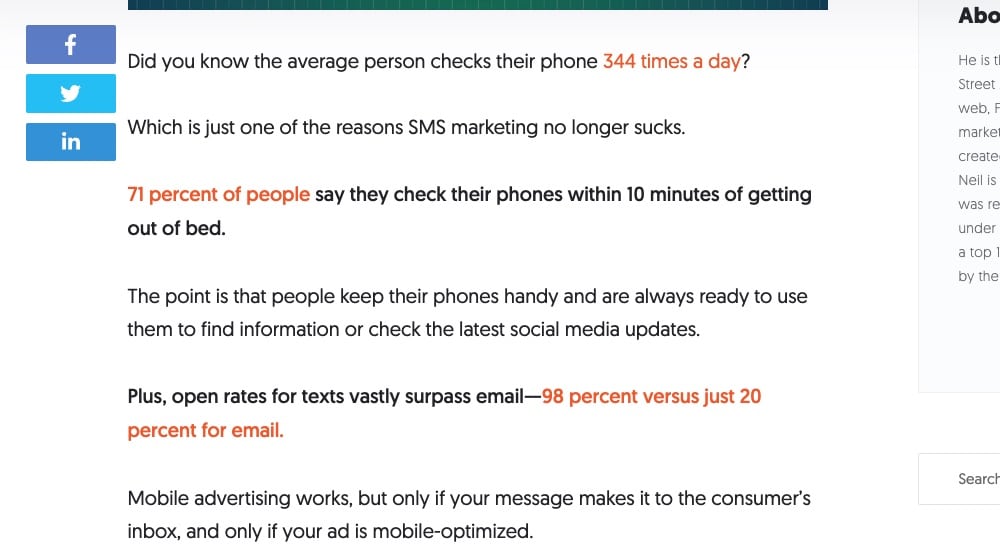
Are they the best possible introductions? Maybe, maybe not. Neil has refined his content production process down to a science, and he happily shares his expertise.
The trouble, I think, is that he doesn't need to win people over. He's already a hugely trusted name in blogging. His introduction doesn't need to convince someone to read on because his reputation already has.
In that first post about blog introductions (guess how I found that post?) Neil specifies that a blog introduction needs three elements to be a success. They are:
- The Hook. A brief, specific, exciting line catches the eye and makes the reader want to read more, even if it's just the second sentence. Often, it can even end up being a single word.
- The Transition. This bridge connects the hook, which can be abstract, to the premise, which is more concrete. The first line is the hook in the SMS example above, and the second/third lines are the transition.
- The Thesis. The thesis is the statement in the introduction of what the post will be about, and it dispenses with the metaphor and gets down to details. Often, it reflects the title of the post.
So, keeping that in mind, let's look at a few more blog introductions.
Example #2 - SmartBlogger
This next example is from a post on SmartBlogger:
The article starts off with:
"What does life look like without knowing your target audience?
It's like going to the grocery store without a shopping list.
You spend money on food you don't need or come home empty-handed.
And yet, that's what you do by making assumptions about who your customers are and what they want.
Businesses and marketers miss many potential customers because they are, in effect, not checking their pantries.
Billions are wasted in ad spending from advertisements that fail to engage the target audience every year.
We know you don't want to waste that kind of money, and that's why this post will walk you through six simple steps to define your target audience."
This introduction has all three elements. It has the hook, in the form of the initial question and the metaphor for shopping, which makes you think about how the two topics are the same. It has the transition in the form of talking about why defining your target audience is essential. And finally, it has the thesis, which comes out and tells you what the rest of the post will report to you.
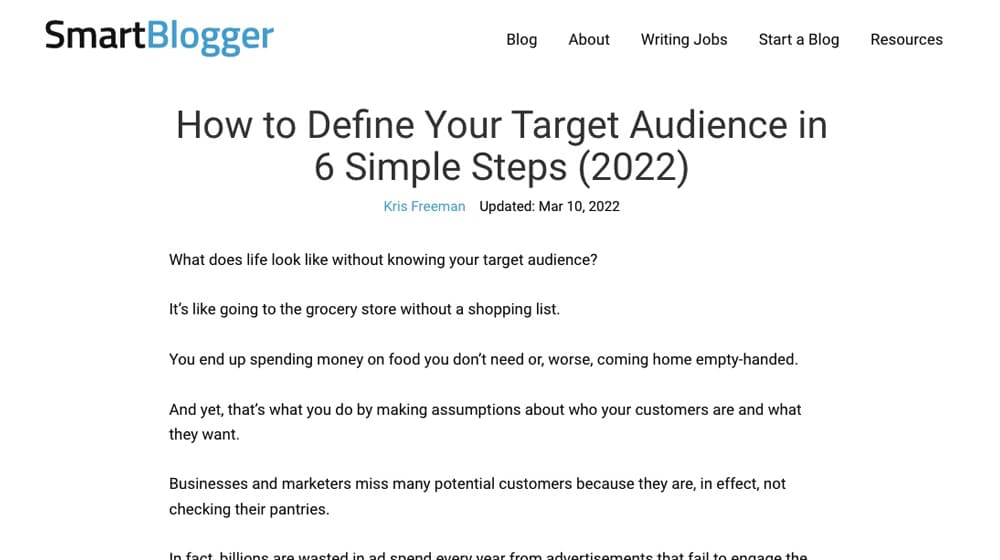
If you'll remember that advice, this is how you do it right.
What's interesting to me is that this post can appeal to all kinds of target audiences. It's a "simple steps" guide, which means it's aimed at beginners and people who need a cheat sheet or "easy mode" for a topic. Yet, it makes a slightly more advanced argument as to why it's necessary to target a more advanced audience. Overall, I like it.
Example #3 - Content Marketing Institute
I have two examples to discuss from CMI. Here's the first one:
It starts off with:
"Content marketers at technology companies have a good handle on content marketing, according to our latest research. They've got a strategy, and they know if it's working because they measure and report results. And most expect more budget to work with this year.
Does that mean tech company marketers avoid the challenges and growing pains that keep their colleagues in other industries up at night?
Not quite.
To find out the challenges tech companies face (as well as they're planning to invest), let's examine the findings in CMI's Technology Content Marketing Benchmarks, Budgets, and Trends with Insights for 2022 sponsored by Foundry. The report reflects responses from 216 content marketers at for-profit technology companies who participated in the 12th annual Content Marketing Institute/MarketingProfs survey in July 2021."
First up is this post. I'm highlighting it because I think the introduction isn't very good.
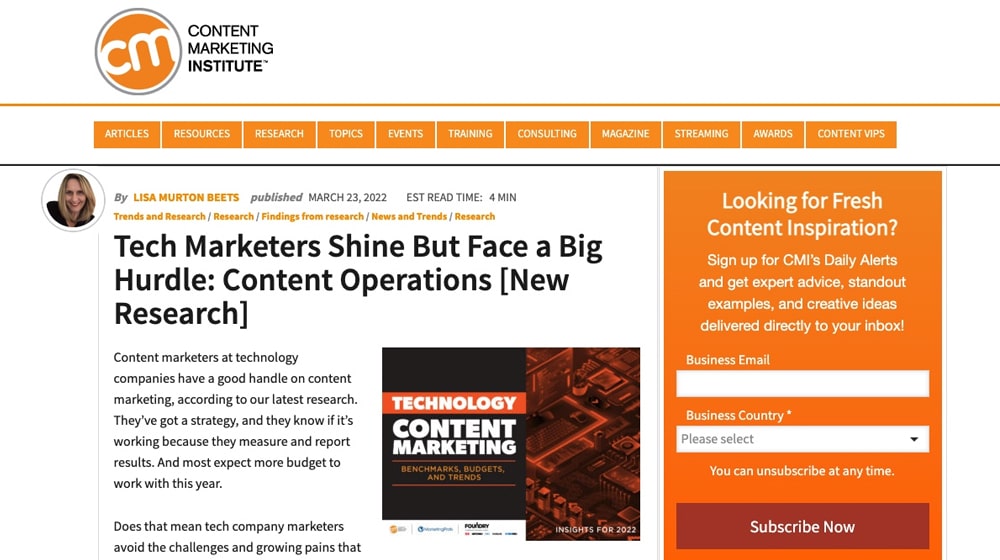
First up, look at the headline. It has the hallmarks of a compelling title in that it poses a situation that should attract attention, but it's a little too stilted and awkward. To me, it reads more like a press release.
Then you get into the introduction itself. "Content marketers are good at content marketing" is meaningless, and that's their opening sentence. The hook isn't there. Again, it reads more like a press release than a valuable blog post. The closest thing to a hook this intro has is the second paragraph, with the question. The last section, though, loses me. I get that they want to showcase their research studies, but I don't want to read academic citations as part of the introduction in the first place. It's not drawing me into the rest of the post.
The worst part is, the study itself is fascinating! There's some compelling information and some excellent digital marketing statistics, but you would never know it from the intro.
Now, look at this second example by CMI:
It starts with:
'Why didn't I think of that?'
The best content marketing examples inspire other marketers. All content marketers want to produce content so good that it sparks joy in its intended audience – and performs well. It doesn't hurt if it earns a little envy from peers.
"Unicorn" content initiatives don't appear out of thin air. It takes work to come up with fresh ideas, align them to your strategic goals and audience interests, and support them with a thoughtful distribution and promotion plan.
No one else's map will get you there, but you can find inspiration for your map. Our latest collection of the best content marketing – 35 Examples of Brands That Are Winning With Content – shows leading B2B and B2C companies that exceeded audience expectations – and their marketing goals – with novel content approaches and creative executions.
Here's a peek at eight of my favorite initiatives and the lessons they teach:"
It has the hook. It draws you in between the title, the opening question, and the immediate first substantive paragraph.
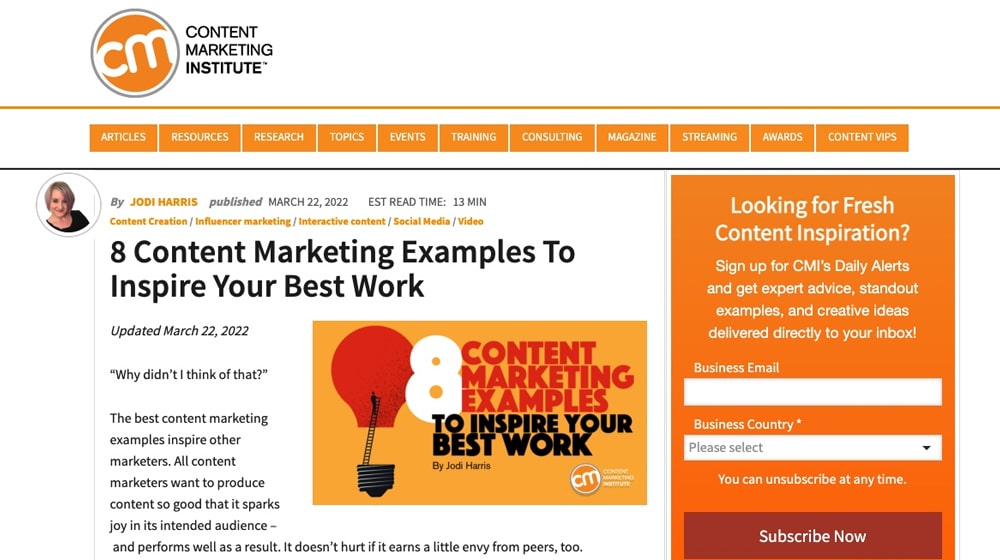
It has a transition. It's slightly different from my other examples because the purpose is different; it's a teaser for a more profound piece of content, an eBook, that they're using as a lead generation tool. But that's the point: this post is valuable because it gives you a substantial, useful hint at a larger, better piece of content. It's not worthless on its own – quite the opposite – but it also promises more.
And, of course, it has the thesis. This strategy tells you what the article will give you – in this case, eight examples and the lessons they teach – and then it immediately launches into the rest of your content.
Example #4 - Search Engine Journal
SEJ is an excellent example to study because it focuses on a different writing kind. Since they're a rapid-fire blog covering search engine optimization news and development, a lot of their content has to be very brief and punchy. It's time-sensitive, so it has to get to you right away.
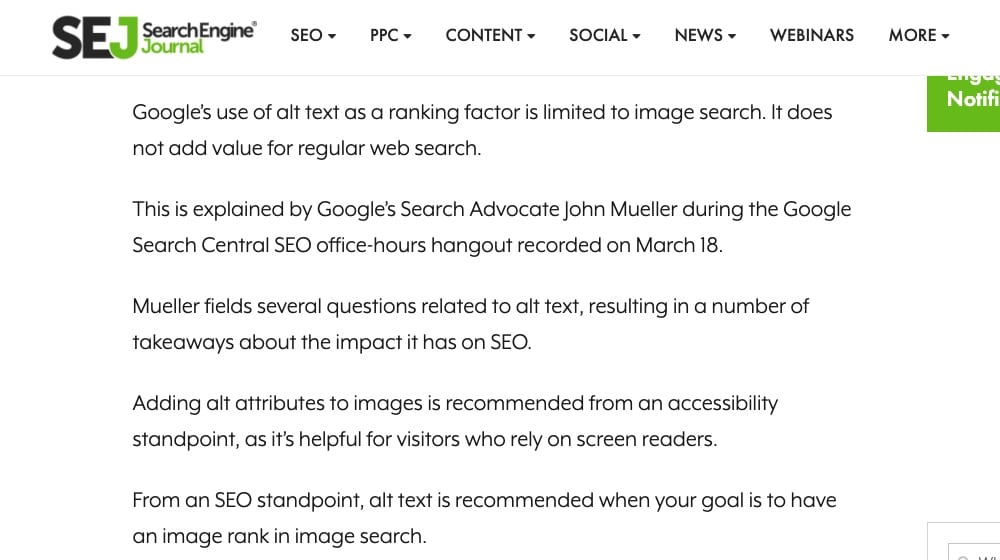
This Search Engine Journal example is from this post:
The article starts off with this paragraph:
"Google's use of alt text as a ranking factor is limited to image search. It does not add value for regular web search.
This is explained by Google's Search Advocate John Mueller during the Google Search Central SEO office-hours hangout recorded on March 18.
Mueller fields several questions related to alt text, resulting in a number of takeaways about the impact it has on SEO."
The full text of the post goes into more resounding advice about alt text, but most of it is stuff you probably already know. The key, and the most critical revelation, is right there in the intro. If you're an experienced SEO, you probably don't even need to read more. But you can, and the full Mueller talk is available as well.
SEJ has plenty of more in-depth content, and their intros are more standard. I just wanted to call out what a more time-sensitive, news-focused, "get the value and move on" introduction might look like.
Example #5 - HubSpot
HubSpot is another massive blog with a ton of value, so you would expect them to be experts in the introduction. Do they?
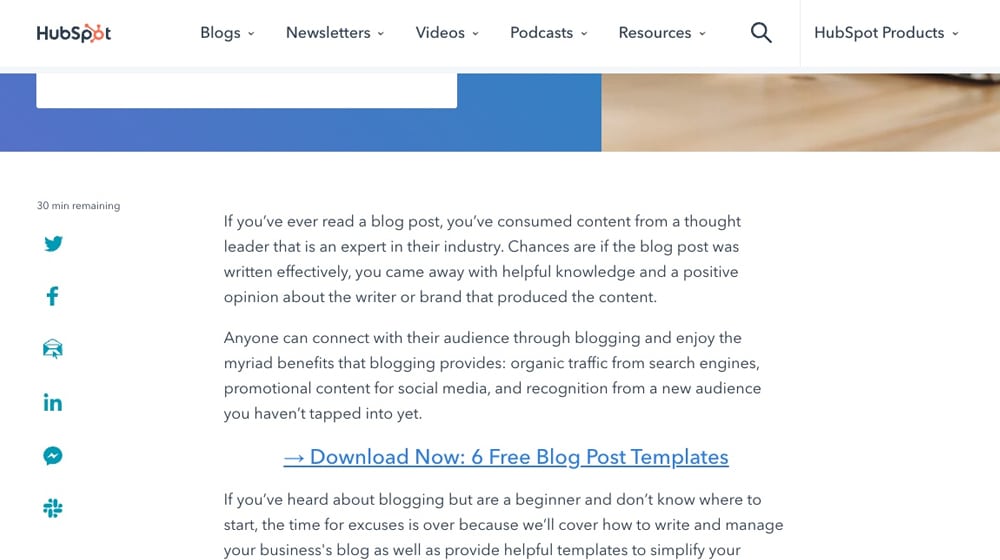
The HubSpot example we're using is:
It starts with:
"If you've ever read a blog post, you've consumed content from a thought leader an expert in their industry. Chances are if the blog post was written effectively, you came away with helpful knowledge and a positive opinion about the writer or brand that produced the content.
Anyone can connect with their audience through blogging and enjoy the myriad benefits that blogging provides: organic traffic from search engines, promotional content for social media, and recognition from a new audience you haven't tapped into yet.
If you've heard about blogging but are a beginner and don't know where to start, the time for excuses is over because we'll cover how to write and manage your business's blog as well as provide helpful templates to simplify your blogging efforts."
As I mentioned above, this falls into the same kind of trap as some of Neil's writing. HubSpot is an industry leader, and their content like this is so deep and so valuable that the introduction almost doesn't matter. Anyone reading this already knows they're getting something good and don't need a hook to finish the rest of the article.
First, it starts on a false premise. I've read plenty of blog posts from people who aren't thought leaders and are often amateurs. I've read plenty of content written ineffectively. I know what they're trying to get at, but their framing isn't the best.
This introduction does have a Thesis, which is excellent. It's also more than a simple blog post. It's a mega-guide; the webmaster's "time to read" is set to 30 minutes, and it's absolutely packed with helpful value. The introduction, to be honest, doesn't matter nearly as much.
Still, I think they could probably improve it. The thing is, I don't believe that improving it would matter all that much.
Example #6 -Backlinko
Here's the post we used for the Backlinko example:
It begins with:
"We analyzed 3.6 billion articles to better understand evergreen content.
Specifically, we looked at a number of different factors (including content formats and promotional channels) that may lead to a higher chance of publishing evergreen content.
With the help of our data partner BuzzSumo, we learned a lot about why certain content continues to get shares and links over time.
Let's get right into the data."
Now, this example is what I'm talking about.
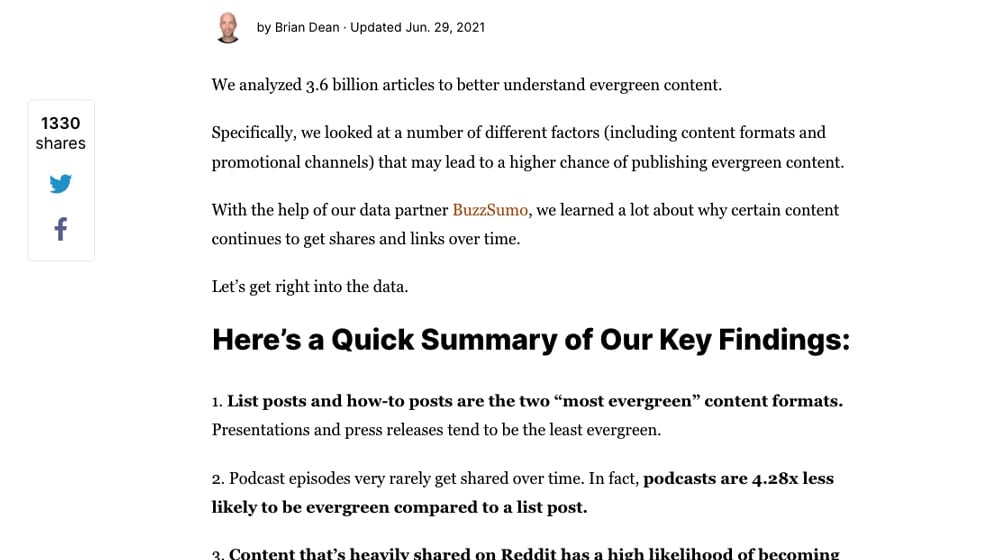
The post has a hook. Plenty of case studies present data, but to analyze billions of articles on their rankings, link building efforts, industry, and title? That's insane. Very few bloggers have the resources to do it, and Brian Dean is one of them. I'm already interested, and the hook hasn't told me why I should be yet.
The transition is there. The hook leads seamlessly into talk of what the reader looked for and where the data came from.
The thesis is there too. It's not just about how evergreen content works; it's about why it works. And that, my friends, is the profound lore I'm interested in learning.
Bad Introductions
While I've already covered the good ones, it's worth talking about a few of the bad ones to give you an idea of what not to do as well.
The Used Car Salesman. The used car salesman is the blog post style that goes deep in on promotion. It's all about you, you, you. Self-promotional content has a harder time ranking in my experience, so an intro that's all about you is more suited to a product page or landing page than a blog post.

The Overt Threat of Doom. Now and then, you find a blog post that is basically a threat. Some claim about how if you don't take some step the blogger says, immediately, your site is going to fail. Very rarely is this actually good – think "critical WordPress vulnerability for widespread day 0 flaw" announcement – but it's usually just exaggeration, and it's a great way to get people to roll their eyes and close your post to find a better one.
The Statistician. This one is just dry. The bland academic writing where the first paragraph is 450 words long and contains seventeen different numbers. It's fine for a medical journal, but not really for a blog post. One statistic can be good. A whole dry term paper intro? Not so much.
What Else Goes Into the Introduction?
I've already talked about the hook, but a good blog post introduction has a little more than just that hook.
The second part of the introduction is the transition. This is a few sentences or a paragraph or two that lead readers from the hook to the actual mechanics of the post. Sometimes it's a little meandering (especially if the hook is further from the core subject), but often it's just a way to frame the topic itself.
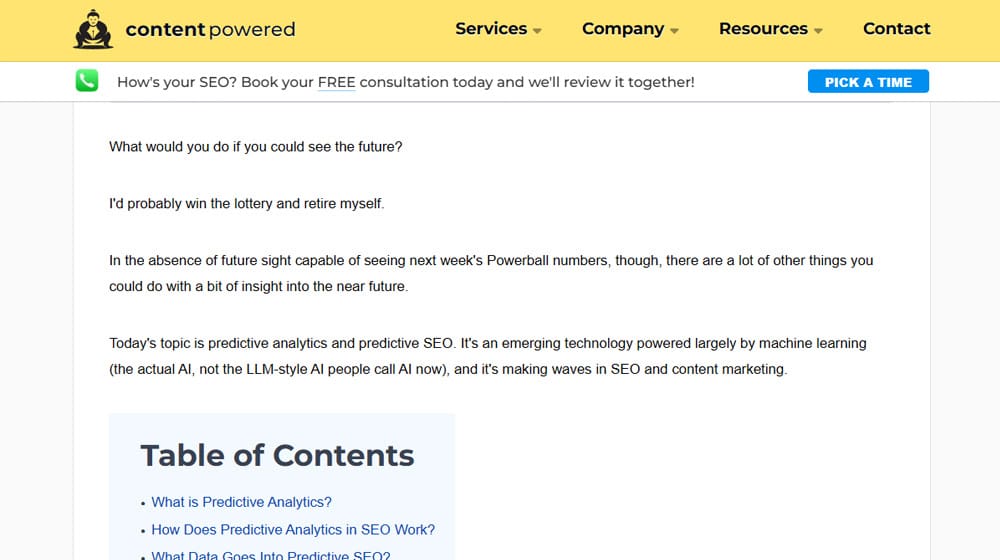
The third element of the introduction is the core thesis. This is where you get down to a more material discussion of what, exactly, the rest of the post is going to contain.
Most of the kinds of intros I discussed above work both for the hook itself and for a general theme for the whole hook-transition-thesis.
Now, go back through your recent blog posts, and tell me: what kinds of intros do you tend to use? You have intros, after all, even if you didn't have intentionality behind them.
What did you fall back on? I'm curious to know. Let me know in the comments below!





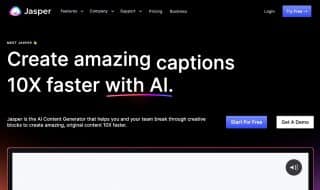

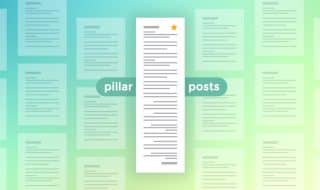


Comments